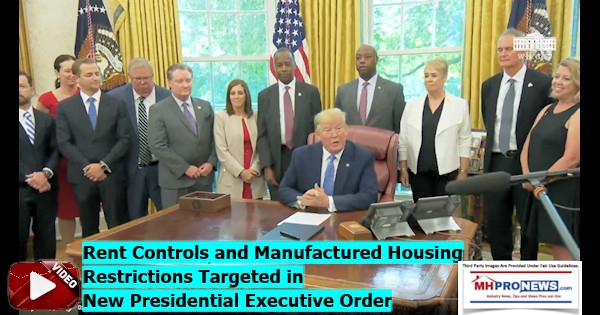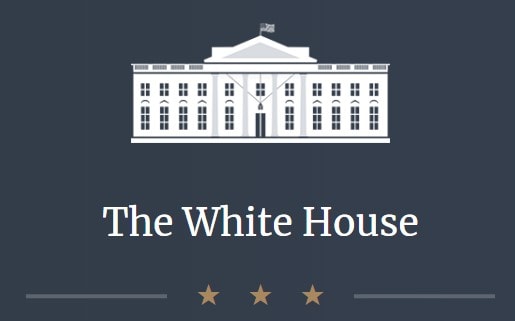
In section one, paragraph 2 of the new presidential executive order are several items that could directly or indirectly impact the manufactured industry.
Two specific items jump out, but there are others. Those two are:
· rent controls;
· outdated manufactured-housing regulations and restrictions;
The Daily Business News on MHProNews has obtained the entire executive order, which will be found below the first posted video, which has the signing ceremony. Following the executive order and another video featuring an interview with HUD Secretary Ben Carson, there will be some additional commentary and analysis.

Executive Order Establishing a White House Council on
Eliminating Regulatory Barriers to Affordable Housing
Issued on: June 25, 2019
By the authority vested in me as President by the Constitution and the laws of the United States of America, it is hereby ordered as follows:
Section 1. Purpose. For many Americans, access to affordable housing is becoming far too difficult. Rising housing costs are forcing families to dedicate larger shares of their monthly incomes to housing. In 2017, approximately 37 million renter and owner households spent more than 30 percent of their incomes on housing, with more than 18 million spending more than half of their incomes on housing. Between 2001 and 2017, the number of renter households allocating more than half of their incomes toward rent increased by nearly 45 percent. These rising costs are leaving families with fewer resources for necessities such as food, healthcare, clothing, education, and transportation, negatively affecting their quality of life and hindering their access to economic opportunity.
Driving the rise in housing costs is a lack of housing supply to meet demand. Federal, State, local, and tribal governments impose a multitude of regulatory barriers — laws, regulations, and administrative practices — that hinder the development of housing. These regulatory barriers include: overly restrictive zoning and growth management controls; rent controls; cumbersome building and rehabilitation codes; excessive energy and water efficiency mandates; unreasonable maximum-density allowances; historic preservation requirements; overly burdensome wetland or environmental regulations; outdated manufactured-housing regulations and restrictions; undue parking requirements; cumbersome and time-consuming permitting and review procedures; tax policies that discourage investment or reinvestment; overly complex labor requirements; and inordinate impact or developer fees. These regulatory barriers increase the costs associated with development, and, as a result, drive down the supply of affordable housing. They are the leading factor in the growth of housing prices across metropolitan areas in the United States. Many of the markets with the most severe shortages in affordable housing contend with the most restrictive State and local regulatory barriers to development.
These regulatory barriers impede our Nation’s economic growth. Hardworking American families struggle to live in markets where there is an insufficient supply of housing — even in markets generating a significant number of jobs. One recent study suggests that certain regulatory restrictions on housing supply have forced workers to live far away from high-productivity areas with the best available jobs, creating a geographic misallocation of labor between cities that may have decreased the annual economic growth rate in the United States by 36 percent between 1964 and 2009.
Low- and middle-income Americans are often hit the hardest by regulatory barriers to housing development. High housing costs place strains on household budgets, limit educational opportunities, impair workforce mobility, slow job creation, and increase financial risks. Furthermore, studies have consistently identified high housing prices as a primary determinant of homelessness, and research has directly linked more stringent housing market regulation to higher homelessness rates.
To help these populations, in 2018, the Federal Government invested more than $46 billion in rental assistance programs for low-income families — much of which grows at approximately 3 percent per annum while assisting a fixed number of households. The Federal Government provides additional housing support through the tax code, with over $9.1 billion in tax expenditures in Low-Income Housing Tax Credits (LIHTC) to developers of low-income housing. Generally, these Federal tax dollars are focused disproportionately on areas with high-cost and highly regulated housing markets.
But to improve housing affordability in a truly sustainable manner, we need innovative solutions — not simply increases in spending and subsidies for Federal housing. These solutions must address the regulatory barriers that are inhibiting the development of housing. If we fail to act, Federal subsidies will only continue to mask the true cost of these onerous regulatory barriers, and, as a result, many Americans will not be able to access the opportunities they deserve.
Sec. 2. Policy. It shall be the policy of my Administration to work with Federal, State, local, tribal, and private sector leaders to address, reduce, and remove the multitude of overly burdensome regulatory barriers that artificially raise the cost of housing development and help to cause the lack of housing supply. Increasing the supply of housing by removing overly burdensome regulatory barriers will reduce housing costs, boost economic growth, and provide more Americans with opportunities for economic mobility. In addition, it will strengthen American communities and the quality of services offered in them by allowing hardworking Americans to live in or near the communities they serve.
Sec. 3. White House Council on Eliminating Regulatory Barriers to Affordable Housing. There is hereby established a White House Council on Eliminating Regulatory Barriers to Affordable Housing (Council). The Council shall be chaired by the Secretary of Housing and Urban Development, or his designee. The Assistant to the President for Domestic Policy and the Assistant to the President for Economic Policy, or their designees, shall be Vice Chairs.
(a) Membership. In addition to the Chair and Vice Chairs, the Council shall consist of the following officials, or their designees:
(i) the Secretary of the Treasury;
(ii) the Secretary of the Interior;
(iii) the Secretary of Agriculture;
(iv) the Secretary of Labor;
(v) the Secretary of Transportation;
(vi) the Secretary of Energy;
(vii) the Administrator of the Environmental Protection Agency;
(viii) the Director of the Office of Management and Budget;
(ix) the Chairman of the Council of Economic Advisers;
(x) the Deputy Assistant to the President and Director of Intergovernmental Affairs; and
(xi) the heads of such other executive departments and agencies (agencies) and offices as the President, Chair, or Vice Chairs may, from time to time, designate or invite, as appropriate.
(b) Administration. The Vice Chairs shall convene regular meetings of the Council, determine its agenda, and direct its work with the oversight of and in consultation with the Chair. The Department of Housing and Urban Development shall provide funding and administrative support for the Council.
Sec. 4. Mission and Functions of the Council. The Council shall work across agencies and offices, with consideration of existing initiatives, to:
(a) solicit feedback from State, local, and tribal government officials, as well as relevant private-sector stakeholders, including developers, homebuilders, creditors, real estate professionals, manufacturers, academic researchers, renters, advocates, and homeowners, to:
(i) identify Federal, State, local, and tribal laws, regulations, and administrative practices that artificially raise the costs of housing development and contribute to shortages in housing supply, and
(ii) identify practices and strategies that most successfully reduce and remove burdensome Federal, State, local, and tribal laws, regulations, and administrative practices that artificially raise the costs of housing development, while highlighting actors that successfully implement such practices and strategies;
(b) evaluate and quantify the effect that various Federal, State, local, and tribal regulatory barriers have on affordable housing development, and the economy in general, and identify ways to improve the data available to the public and private researchers who evaluate such effects, without violating privacy laws or creating unnecessary burdens;
(c) identify and assess the actions each agency can take under existing authorities to minimize Federal regulatory barriers that unnecessarily raise the costs of housing development;
(d) assess the actions each agency can take under existing authorities to align, support, and encourage State, local, and tribal efforts to reduce regulatory barriers that unnecessarily raise the costs of housing development; and
(e) recommend Federal, State, local, and tribal actions and policies that would:
(i) reduce and streamline statutory, regulatory, and administrative burdens at all levels of government that inhibit the development of affordable housing, and
(ii) encourage State, local, and tribal governments to reduce regulatory barriers to the development of affordable housing.
Sec. 5. Reports. The Vice Chairs, on behalf of the Council, and with the oversight of and in consultation with the Chair, shall:
(a) within 12 months of the date of this order, submit to the President a report on the Council’s implementation of section 4 of this order; and
(b) submit to the President any subsequent report that the President may request or that the Council may deem appropriate.
Sec. 6. Agency Participation and Response. The heads of agencies and offices shall provide such assistance and information to the Council, consistent with applicable law, as may be necessary to carry out the functions of this order.
Sec. 7. Termination. The Council shall terminate on January 21, 2021, unless extended by the President.
Sec. 8. General Provisions. (a) Nothing in this order shall be construed to impair or otherwise affect:
(i) the authority granted by law to an executive department, agency, or the head thereof; or
(ii) the functions of the Director of the Office of Management and Budget relating to budgetary, administrative, or legislative proposals.
(b) This order shall be implemented consistent with applicable law and subject to the availability of appropriations.
(c) This order is not intended to, and does not, create any right or benefit, substantive or procedural, enforceable at law or in equity by any party against the United States, its departments, agencies, or entities, its officers, employees, or agents, or any other person.
DONALD J. TRUMP
THE WHITE HOUSE,
June 25, 2019.
##
HUD Secretary Ben Carson on Issues Related to New Executive Order
Related News Tip
An emailed news tip came in that read as follows.
From an industry source:
“On the surface, this appears to be good news. But I want to draw your attention to the following regarding zoning and regulatory compliance:
‘More than 25% of the cost of a new home is the direct result of Federal, State, and local regulations, with the price tag even reaching up to 42% for some new multifamily construction.’
Manufacturers will tell you that one of the key cost drivers between modular and manufactured homes is the higher inspection costs under the IRC and state building codes for modular homes. This can cause modular homes to be 15% to 20% more costly than manufactured homes. If the Administration somehow is successful in reducing those costs, the competitive advantage of manufactured homes begins to erode.”
That will be a concern to monitor. But there are other potential road blocks and hurdles ahead too.
National Low Income Housing Coalition President and CEO Diane Yentel said in part, “An effort by this administration to address restrictive local zoning would be welcomed if it weren’t belied by other actions to gut affordable and fair housing in America. The council, made up of the Secretaries of Treasury, Labor, Agriculture and the EPA, will likely work to remove important federal regulations that protect fair wages, fair housing, the environment, and more, and not the restrictive local zoning over which the federal government has very little control.”
NIMBY and green groups, among others, have or will be expected to raise concerns too.
MHProNews will return to this developing issue in an upcoming report, which will likely reference these points.
That’s this pre-dawn installment of manufactured home “Industry News, Tips, and Views Pros Can Use,” © where “We Provide, You Decide.” ©. ## (News, fact-checks, analysis, and commentary.)


1) Marketing, Web, Video, Consulting, Recruiting and Training Resources
Submitted by Soheyla Kovach to the Daily Business News for MHProNews.com. Soheyla is a managing member of LifeStyle Factory Homes, LLC, the parent company to MHProNews, and MHLivingNews.com.
Related Reports:
You can click on the image/text boxes to learn more about that topic.
MHARR Reiterates Call for DTS Investigation | Manufactured Housing Association Regulatory Reform
Washington, D.C., June 18, 2019 – The Manufactured Housing Association for Regulatory Reform (MHARR), in a June 13, 2019 communication to Fannie Mae Vice President Jonathan Lawless (copy attached), has reiterated its call for a congressional investigation into the failure of both Fannie Mae and Freddie Mac to implement the statutory Duty to Serve Underserved …
MHARR Calls on HUD Secretary to End Discriminatory And Exclusionary Zoning of HUD-Regulated Manufactured Homes | Manufactured Housing Association Regulatory Reform
Washington, D.C., April 30, 2019 – The Manufactured Housing Association for Regulatory Reform (MHARR) in an April 24, 2019 communication to U.S. Department of Housing and Urban Development (HUD) Secretary, Ben Carson (copy attached), has called on the Department to federally preempt local zoning ordinances which discriminatorily exclude manufactured homes regulated by HUD pursuant to the National Manufactured Housing Construction and Safety Standards Act of 1974 and the Manufactured Housing Improvement Act of 2000.
Photo of Commodore Homes model, MHARR logo, are provided under fair use guidelines. See article and letter to Secretary Carson, linked here.

























